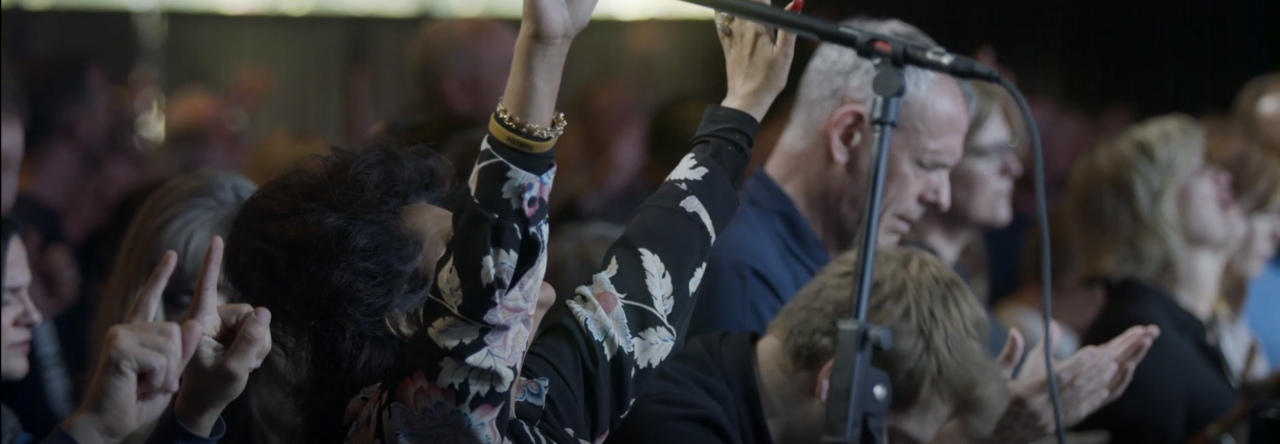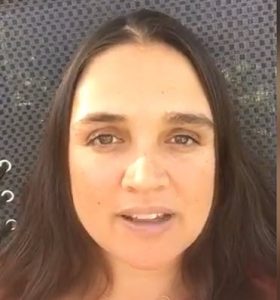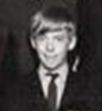It is coming up on two years since I began therapy in March 2019. I think the pandemic has driven a lot of people into treatment. Good thing I got a headstart on it! This article is about my progress in processing my emotional pain and the importance of emotional connection in rediscovering my authentic self. You can read the complete article on my blog at https://mike.mcloughlin.com.
I have learned in therapy that family of origin issues are at the root of most therapeutic problems. I have discovered many interesting facts about my family of origin since I began this process.
My Grandfather’s Nickname

My grandfather and I
One of the facts is that my grandfather had a nickname. He was a naval commander during the second world war. He captained a destroyer that escorted supply ships across the Atlantic to protect them from U Boat attack. He had quite the reputation with the seamen under his command. He was known as a strict disciplinarian. He wanted to keep up morale. The seamen referred to him as “Herr Pullen.” His staff experienced him as a formidable disciplined leader like a German U-boat commander.
He lived in a place called Chester Basin, Nova Scotia. I lived in Vancouver, British Columbia. I did not get to see much of him growing up. In the summer of 1977, I happened to be working a job in Nova Scotia. After the summer was over, I spent a week with him at his home. I was eighteen years old.
He liked to sail. He had a small two-masted schooner harboured at his place on the Atlantic Ocean. One afternoon, he invited me out sailing with him. I had learned to sail in high school, and I thought I was good at it, so I accepted his invite.

Venture
Sailing a Schooner
The boat we were sailing on was a least 40 years old. It was designed and built in the province of Nova Scotia. Made entirely out of wood, it was antique and irreplaceable. My grandfather was proud of his boat and how well he had cared for it. I think he enjoyed showing it off to his grandson. The name of the ship was “Venture.”
It was a breezy afternoon in late September 1977. The sun was shining when he took me out on his boat. He liked to bark orders at me. I managed to do most things even though I was unfamiliar with the ship. It was a special time to be with my grandfather. I was feeling proud to be at his side as he deftly maneuvered the boat around the bay.
After a fantastic afternoon, it was time to return home. My job was to help moor the boat to a buoy in the bay outside his house. Then we could clamber into a dingy and row back to the dock. I had in hand a boat hook. It was a long wooden pole with a bronze hook. I laid down on my stomach just back from the bow of the boat. I had the boat hook stretched out in front of me, ready to catch the buoy as we slowly glided toward it.
As we approached the buoy, I reached forward with the boat hook. I wanted to catch it the first try. Instead, I misjudged the distance and dropped the hook too soon. It fell out of my hands. The bronze hook plunged into the water and disappeared below the surface.
“You fool!” my grandfather shouted! It was a loud, angry shout. It was the kind of cry that he issued to a crew member who had fumbled a depth charge, nearly blowing a hole in the ship!
My heart sank! I had just ruined one of the most important afternoons of my life. I felt terrible! I groaned as I watched the hook sink below the water.
Then something strange happened. The wooden shaft of the boat hook reappeared from the water just enough for me to catch it. I grabbed it, pulled it up, caught the loop in the buoy, and moored the boat.
My grandfather said nothing. I said nothing. I felt terrible that I had dropped it. Even though I had recovered it, I felt I was in his bad books now. I felt his disapproval, and there was nothing more to do about it other than to bear it.
You Fool! – Two Words that shaped my Life
Two words! “You fool!” It sums up the source of so many problems in my life. I can trace my father wounds; my mother issues; my lack of self-esteem; my feelings of worthlessness; my people-pleasing practices; my anxious attachment style; my avoidance of emotional pain; and my numbing out through alcohol, overeating and sexual addiction back to those two words and the family system they represent.
My grandfather and through him, my mother, believed perfection was possible! They thought it was possible to live a mistake-free existence. Their standard was complete one hundred percent perfection. Anything less than perfection was unacceptable. No one in my family could ever achieve it, but that did not make it any less worthy as a goal. There was no grace for mistakes, no mercy for error. You just had to bear your shame.
As a little boy, if I behaved and were obedient, my parents would love me. If I acted out, I got emotional, or I misbehaved, I was disciplined and made to feel ashamed. My parents would often scold me that my bad behaviour reflected poorly on their parenting skills.
To err is human was not true in our family system. If an untoward event happened, you could curse your luck, make a fuss, and perhaps if you were loud enough and angry at yourself enough, you would get a meagre measure of sympathy. Otherwise, it would be best if you bore the ignominy of it in silence. “Suck it up, buttercup!” was our family’s form of empathy.
I am Impenetrable
Suffice it to say. I experienced a lot of emotional pain, much of which I still carry around today, as I have discovered in therapy.
I used to be a believer in the adage of never opening up that emotional “can of worms.” I could not understand why people needed to revisit their past and talk about their emotional issues. I felt pity for the therapist who had to listen to people complain about their emotional pain. That was a nasty business, and I believed it could be safely ignored, or so I thought!
Not until my business failed, relationships soured, strain in my marriage, my children suffered, and I was busted for being addicted to porn did I wake up to the fact that I had a problem.
I asked my wife what it was like to experience me as her husband. She took out a white paper sheet, drew a stick figure in the middle, and labelled it “Mike.” Then she drew a large circle around me and wrote the word impenetrable beside it!
She experienced me as disconnected and closed off from human contact. There was no way into me. I was a hard shell. Efforts to connect with me were impossible. I was impenetrable!
I was not surprised by this description. My family of origin was not known for its soft eyes or caring connection. Having lived various experiences of being vulnerable, making mistakes and being labelled a “fool” for them, I became accustomed to building a hard casing of emotional protection around my vulnerable self.
The Battle for my Identity
Growing up, I was in a constant battle for my identity. My father was controlling and critical. He had no sense of boundaries. He saw me as an extension of himself hence the concern that I behave. He wanted me to be like him. He was a lawyer: smart and dominant. He was the “Alpha male” in our family. Always in control. He never let his emotions show. He could not understand why I would make different choices than him. He was embarrassed by my frequent emotional upsets. Toughen up was his advice to me. Be a man! I felt like I was continually disappointing him.
I attended a boy’s private school. I was the youngest boy in my class. The bullying was without mercy. It was the way of the British private school system. I was the runt of the class. I was insecure. I stuttered. I got emotional when the boys picked on me. I took things personally. I waved my hands about when I talked. It earned me the nickname “Gibble.”
Whether it was at home or school, I was in a constant battle for my identity. With my dad, I was a disappointment. At my school, I was a Gibble. I learned to hide my emotional, sensitive side, my authentic self that desperately wanted to connect with friends and family. The echo of my grandfather’s “You fool!” reverberated through my life, keeping me closed off and distant from others.
Over time I developed coping mechanisms as a “thick skin” to manage the pain. I buried and suppressed all thoughts or feelings that made me feel vulnerable. I became “defended against vulnerability.”
In this state of emotional shutdown, I became self-reliant and independent. I worked for no one. I took orders from no one. I depended upon no one. I connected to no one. I refused to have others label me or tell me who I was. I was the one to decide that, and the way I did that was to attach myself to whatever external thing I was doing that gave me a sense of purpose or meaning. What I did was who I was. I was the owner and operator of my own business.
Lost in the Shuffle was my Authentic Self
This identification worked well enough until my business failed. My identity as an independent business owner lost; I lost a sense of self. My shell was hollow. I felt like there was a hole in my soul where my identity ought to be. I had always defined myself from the outside in. I had not chosen this approach. It was forced upon me by my father and by my school experience. It became how I lived my life. It became who I was.
Some cancer survivors have this saying. “I am not my cancer.” Their battle against the disease is so overwhelming and continuous that it comes to define who they are, as in, “I am a cancer survivor.” Unless they consciously realize what is happening and keep hold of their identity, they are at risk of losing it to the label “cancer survivor.” When they do survive cancer, they find it difficult to move on from that identity.
Unaware of what was happening to me, my struggle for independence from my father and freedom from a bullying school system came to define me. Always having to prove myself to others or my dad became my life purpose. I had to tick all the boxes of the system. Was I a man? Was I doing all the man things? Was I providing for my family? Was I faithful to my wife? Did I have status in the community? Was I a successful business owner?
Whenever I took on a new role in my career, I would think about how it would impress my father or show others my importance. I thought with this new role; I would feel confident I could form relationships. No one could doubt me because I had the credentials or I had the success to prove those doubts wrong.
Lost in the shuffle was my authentic self. Without an authentic self, my wife and my friends had no one to really connect to. I was all about the current role I was playing at that moment. I was cut off from my emotions and my inner world. My authentic self was imprisoned behind a protective system that had as its purpose the goal of keeping my emotions out of conscious awareness. To do that it had to exile that part of me that was my authentic self. I became depressed, isolated and lonely.
This was my state going into therapy.
Like it or not, the Pain surfaces
After two years of therapy and one year of pandemic, my emotional protective system has completely collapsed. “This has been the most painful year of my life.” That statement pretty well sums it up.
It is like I have these beach balls filled with emotional pain. I am trying to keep them all underwater. But it takes a lot of emotional energy to pretend I am okay, and I am getting tired. So I am letting go of the effort.
My pain is surfacing, whether I like it or not. Some of it quietly, Other parts are popping up unexpectantly. Triggers are a problem. I am overreacting to emotional stimuli. I can become sentimental about silly things. Then someone draws a boundary, and I push back on it hard only to realize they are right and entirely justified! Then I feel out of control. I feel I need to shut my emotions down again, or I risk further embarrassing myself.
I want to connect emotionally with my peers, but I fear the pain of abandonment, so I hide my vulnerability. I fear the judgment of my former business associates because I failed to meet expectations. Most of all, I fear my friends and family’s disappointment and those who depend upon me to set a good example as a son, a husband, a father, and a friend.
I have finally been able to open up to my wife. Now she is experiencing me as “connectable.” The circle is now penetrable! Her empathy is helping me.
Letting go of the Pain
When I was seven, I was playing with a bamboo cane. I impaled my index finger with a sharp splinter. It was excruciating.
My mother rushed me to the doctor. When we got to his office, he was busy, so we had to wait.
His partner could see us, so we went to see him. I was crying and making a big fuss. My mother was trying to settle me down. The doctor was talking to her.
I heard a noise from the adjoining room. I saw my usual doctor there motioning for me to come and see him. So I did.
He was hiding something behind his back. I climbed up into his lap to show him my finger. Suddenly, he grabbed it, whipped out a pair of plyers and pulled the splinter out of my finger. I was so shocked I hardly said anything.
I sat in his lap a while, feeling the pain. He let me sit there. After a time, I settled down. I felt like he cared for me. I felt like he understood my pain. When I felt like he understood, I could let it go. I climbed down from his lap, and I went to show my mother. She was surprised and glad to see the splinter gone.
There is No Quick Fix
I have lived 60 plus years with a large splinter in my heart. For this pain, there is no sudden removal—just a long slow process over time. I must plod through it to get to the other side of it.
I wish there were another way of dealing with it. I have tried to push past the pain with a quick fix or a formula or a positive declaration. More often than not, these fixes are a way of bypassing the pain or papering over it rather than removing it altogether.
So, for me, the goal right now is to “process” the pain, connect with it and sit with it awhile. Feel it. Acknowledge it. Validate it. Take a deep breath. Release it. Connect. Share it with others. Let it go. Then repeat.
I am listening to a song by JJ Heller. I connect with her words.
“Loved” by JJ Heller (Youtube Link; Spotify Link; iTunes Link)
Do you dream of a home you never had?
An innocence that you cannot get back
The pain is real, you can’t erase it
Sooner or later you have to face it down, down
You have to face it down
You are loved
Do you keep your thoughts inside your head?
Do you regret the things you never said
You have a voice, you have to use it
You have a choice, don’t let them shut you down, down
Don’t let them shut you down
You are loved
You are loved
Do you feel the ache inside your soul?
You know you’ll never make it on your own
Sorrow is too great for you to hold it
You’re gonna break, why don’t you lay it down?
(Bridge)
Freedom comes in letting go
Open up the window to your heart
Freedom comes in letting go
Open up your heart
You are loved
You are loved
You are loved
You are loved
You are loved
You are loved
You are loved
You are loved

 “If you’re tired of starting over, stop giving up.”
“If you’re tired of starting over, stop giving up.”


